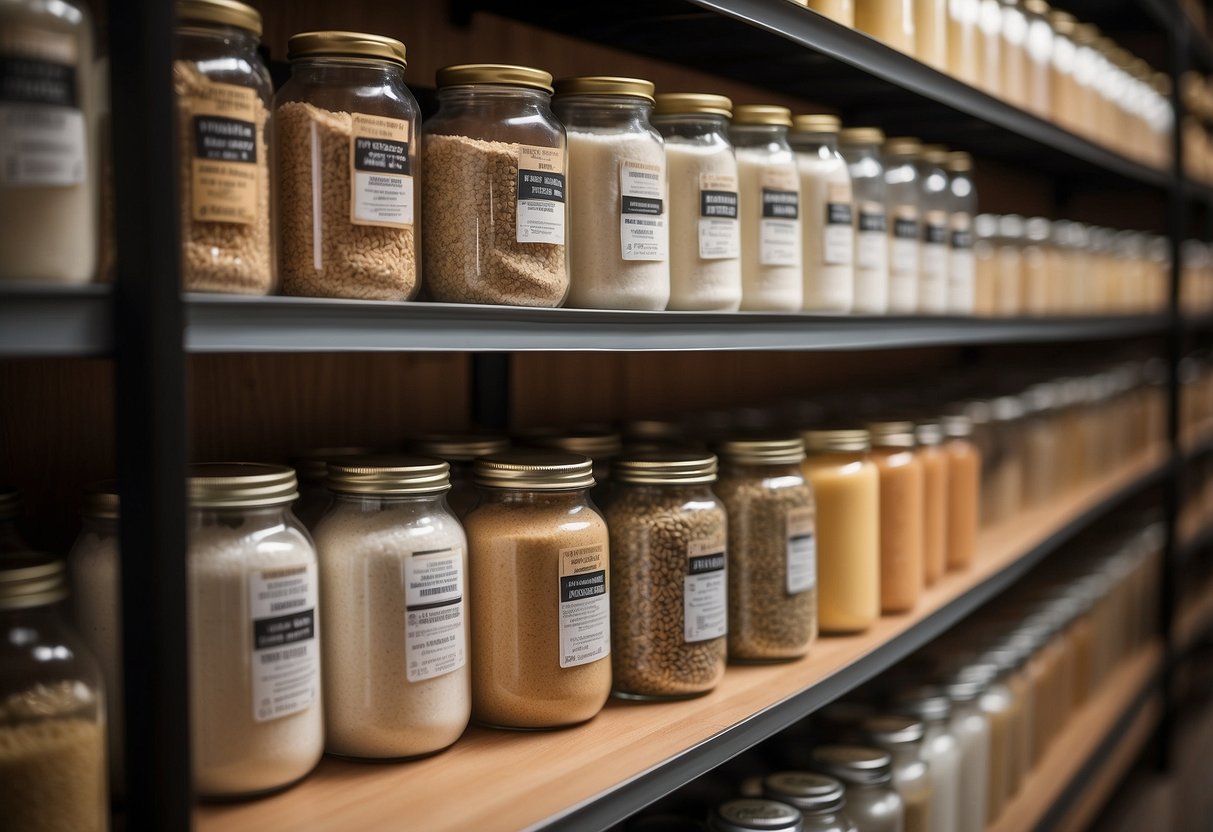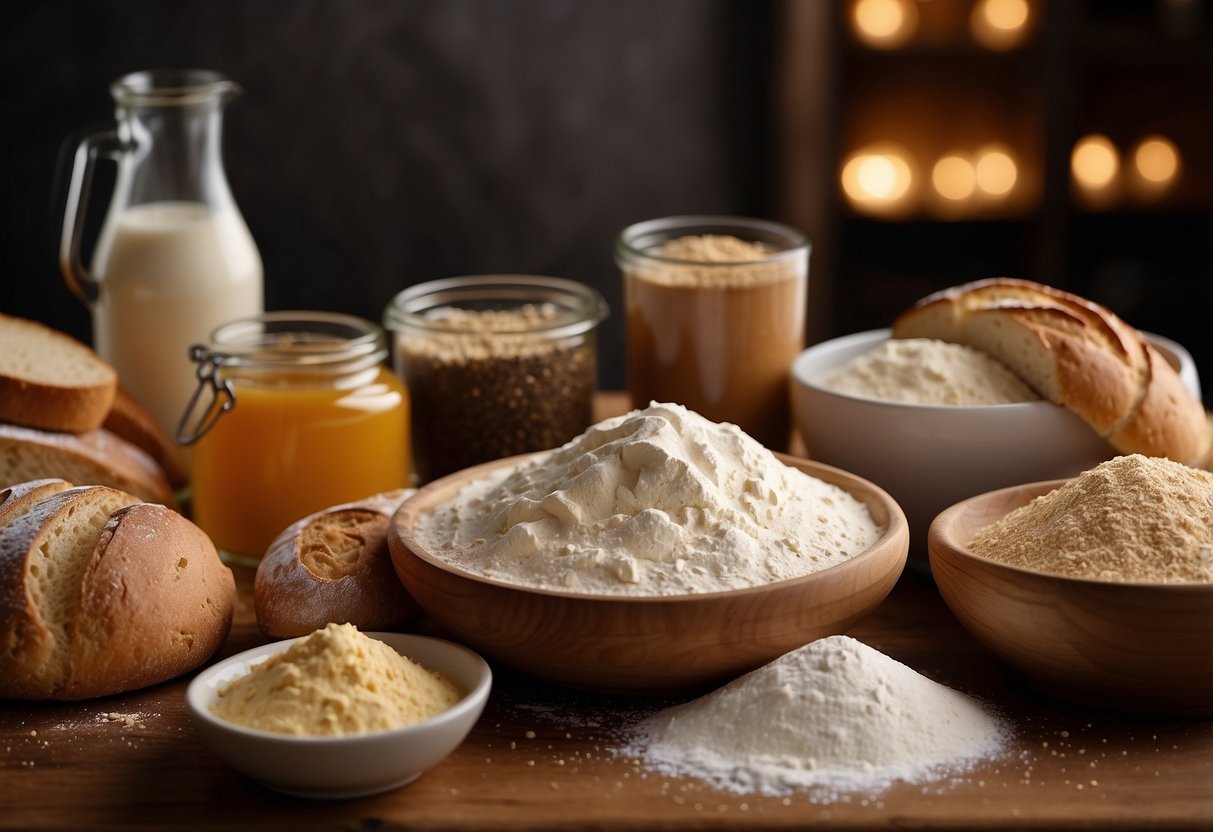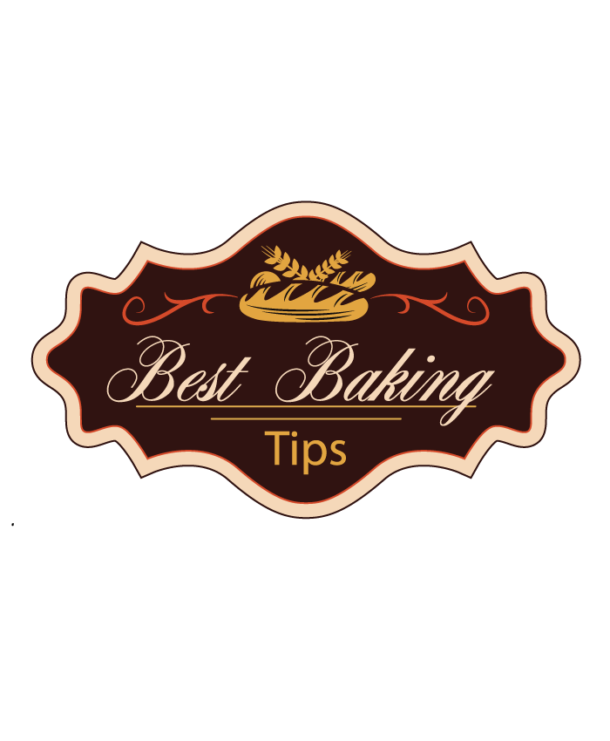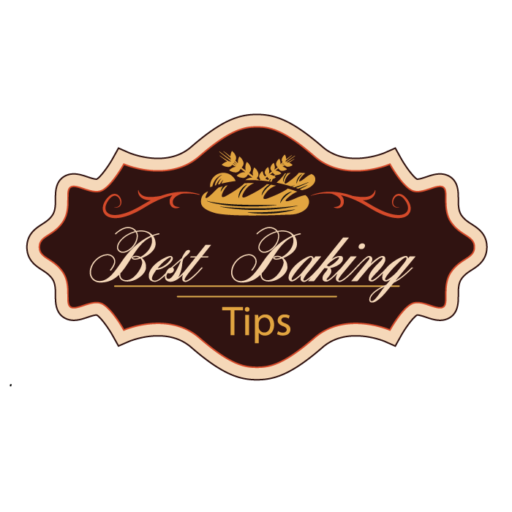==================
Affiliate Statement
Best Baking Tips is supported by our audience. When you purchase through one of our links, we may earn a small affiliate commission. As an Amazon Associate I earn from qualifying purchases. Your cost is not affected.
==================
Guide To Different Types Of Flour
Essential Baking Knowledge
Flour is a key ingredient in many recipes, but not all flours are the same. As a baker, I’ve learned that choosing the right type of flour can make or break a dish.
Different flours have unique properties that affect texture, flavor, and nutritional value in baked goods.

All-purpose flour is the most common type, but there are many other options. Whole wheat, bread flour, and pastry flour are just a few examples.
Each type serves a specific purpose in baking. Using the right flour can elevate a recipe from good to great.
In this guide, I’ll share my knowledge about various flour types and their best uses. Whether you’re making bread, cakes, or gluten-free treats, understanding flour is crucial for success in the kitchen.
Key Takeaways
- Flour types vary in protein content, affecting texture and structure in baked goods
- Some flours are better suited for specific recipes, like bread flour for chewy textures
- Proper storage and handling of flour ensure freshness and prevent spoilage
The Basics of Flour

Flour is a key ingredient in baking and cooking. It comes from different grains and has various uses. Let’s explore what flour is, where it comes from, how it’s made, and what it contains.
What Is Flour?
Flour is a fine powder made by grinding grains, seeds, or roots. I use it as a base for many foods. It’s the main ingredient in bread, pasta, and baked goods.
Different types of flour have unique properties that affect how they work in recipes.
Some flours make bread rise well, while others are better for cakes or cookies.
Flour can be whole grain or refined. Whole grain flour uses all parts of the grain. Refined flour only uses the inner part.
Common Grain Sources
I find wheat is the most common source for flour. But there are many others:
- Wheat
- Rye
- Barley
- Oats
- Corn
- Rice
Each grain gives flour its own flavor and baking qualities.
Wheat flour is versatile and works in many recipes. Rye flour makes dense, flavorful bread. Meanwhile, corn flour is great for cornbread and tortillas.
Some flours don’t come from grains. Almond and coconut flours are examples. These are good for gluten-free baking.
Process of Flour Production
Making flour involves several steps:
- Cleaning the grain
- Tempering (adding moisture)
- Grinding
- Sifting
First, I clean the grain to remove debris. Then, I add moisture to soften it. This makes grinding easier.
Grinding turns the grain into flour. I can use stone mills or steel rollers for this. The method affects the flour’s texture and nutrition.
Sifting removes larger particles. This gives flour its fine texture.
Some flours go through extra steps. Bleaching makes white flour whiter, and enriching adds back nutrients lost in refining.
Nutritional Components
Flour contains several key nutrients:
- Carbohydrates
- Protein
- Fiber
- Vitamins (B vitamins, vitamin E)
- Minerals (iron, zinc)
The amounts vary based on the grain source and processing.
Whole wheat flour has more fiber and nutrients than white flour.
Protein content is important in baking. It affects how the flour behaves.
High-protein flour, like bread flour, creates strong gluten networks. This is good for chewy breads. Meanwhile, low-protein flour, like cake flour, makes tender baked goods.
I always check the nutrition label when choosing flour. This helps me pick the right type for my dietary needs and baking goals.
Wheat Flour Varieties
Wheat flour comes in several types, each with unique properties. I’ll cover the main varieties and how they differ in texture, protein content, and best uses. These flours form the foundation of many baked goods.
Whole Wheat vs. White Flour
Whole wheat flour contains the entire wheat kernel, including the bran and germ. It has a nuttier flavor and more nutrients than white flour. White flour only uses the endosperm of the wheat kernel.
Whole wheat flour:
- Higher in fiber and nutrients
- Denser texture in baked goods
- Shorter shelf life
White flour:
- Lighter texture
- Longer shelf life
- Less nutritious
I often mix whole wheat and white flour for a balance of nutrition and texture. This works well in breads and muffins.
White whole wheat flour is a good option for a lighter color and milder flavor while keeping the nutrients.
Cake Flour and Pastry Flour
Cake and pastry flours have lower protein content, making them ideal for tender baked goods.
Cake flour:
- Very fine texture
- About 7-9% protein
- Best for cakes and delicate pastries
Pastry flour:
- Slightly higher protein than cake flour (8-9%)
- Good for pie crusts, cookies, and biscuits
I use cake flour for the lightest, fluffiest cakes. Meanwhile, pastry flour works well for tender but slightly sturdier baked goods.
If I don’t have cake flour, I can make a substitute by replacing 2 tablespoons of all-purpose flour with cornstarch for each cup.
Bread Flour
Bread flour has a high protein content, usually 12-14%. This extra protein creates more gluten, giving bread its chewy texture and helping it rise.
Key features:
- Creates strong, elastic dough
- Produces chewy texture in bread
- Helps bread hold its shape
I use bread flour for yeasted breads, pizza dough, and bagels.
It’s not ideal for cakes or pastries, which need a more tender crumb. For whole grain bread, I might mix bread flour with whole wheat flour to get a good rise and hearty flavor.
Self-Rising Flour
Self-rising flour is a convenient blend of all-purpose flour, baking powder, and salt. It’s commonly used in biscuits, pancakes, and quick breads.
Composition:
- All-purpose flour
- Baking powder (about 1.5 teaspoons per cup of flour)
- Salt (about 1/4 teaspoon per cup of flour)
I find self-rising flour handy for quick recipes. But it’s easy to make at home by mixing the ingredients.
It’s important to note that self-rising flour isn’t suitable for yeast breads. The added leavening can interfere with the yeast’s action.
Gluten-Free Flours
Gluten-free flours offer alternatives for those with celiac disease or gluten sensitivity. I’ll cover four popular options that can be used in baking and cooking.
Rice Flour
Rice flour is a versatile gluten-free option. I find it works well in many recipes as a wheat flour substitute.
It comes in white and brown varieties, each with its own properties.
White rice flour has a neutral flavor and light texture. I use it for cookies, cakes, and as a thickener for sauces.
Meanwhile, brown rice flour has a nuttier taste and more fiber. It’s great for heartier baked goods like bread and muffins.
When baking with rice flour, I often mix it with other gluten-free flours for better texture. It can be a bit gritty on its own. Adding xanthan gum helps improve the structure of baked goods.
Coconut Flour
Coconut flour is highly absorbent and adds a subtle coconut flavor to dishes. I use it sparingly as it soaks up a lot of liquid.
This flour is rich in fiber and protein. It works well in pancakes, muffins, and quick breads.
I usually combine it with other flours for best results.
When using coconut flour, I increase the amount of eggs or liquid in the recipe. It typically requires about 6 eggs per cup of flour. This helps prevent dry, crumbly results.
Coconut flour has a sweet taste, so I often reduce the sugar in recipes when using it. It’s also great for coating meats before frying.
Almond Flour
Almond flour is made from ground almonds. It adds moisture to baked goods. I love its nutty flavor and high protein content.
This flour works well in cookies, cakes, and pie crusts. It creates a tender crumb in baked goods. I often use it in combination with other gluten-free flours for better texture.
Almond flour is not as absorbent as grain-based flours. I usually reduce the amount of liquid or fat in recipes when using it. It’s also great for breading meats and vegetables.
One thing to note: almond flour can brown quickly. I keep an eye on baked goods and sometimes lower the oven temperature to prevent burning.
Buckwheat Flour
Despite its name, buckwheat is not related to wheat and is gluten-free. I appreciate its earthy, slightly bitter flavor in pancakes and crepes.
Buckwheat flour is nutrient-dense, high in fiber and protein. It works well in bread, muffins, and pasta. I often mix it with other flours to balance its strong taste.
This flour absorbs liquid quickly, so I let batters rest before cooking. This allows the flour to fully hydrate and improves texture.
Buckwheat flour can make baked goods dense. I use it in recipes that don’t require much rising, like flatbreads. For lighter results, I combine it with starches or other gluten-free flours.
Alternative Grain Flours
Alternative grain flours offer unique flavors and textures for baking. They can add nutrition and variety to recipes. I’ll cover three popular options: rye, oat, and spelt flour.
Rye Flour
Rye flour has a deep, earthy flavor. It’s often used in rustic breads and crackers. This flour is high in fiber and low in gluten.
I find rye flour works best when mixed with wheat flour. A good ratio is 1 part rye to 2 parts wheat. This helps bread rise better.
Rye flour comes in light, medium, and dark varieties. The darker the flour, the stronger the flavor. Dark rye flour makes dense, flavorful pumpernickel bread.
Baked goods with rye flour stay moist longer. They have a chewy texture many people enjoy. Rye flour also pairs well with bold flavors like molasses and caraway seeds.
Oat Flour
Oat flour is naturally gluten-free and has a mild, slightly sweet taste. I make it easily by grinding rolled oats in a food processor.
This flour adds moisture and a tender crumb to baked goods. It’s great for cookies, muffins, and pancakes. Oat flour can replace up to 25-30% of wheat flour in most recipes.
Oat flour is nutritious, with more protein and fiber than white flour. It also contains beta-glucan, which may help lower cholesterol.
When baking with oat flour, I often add a bit more liquid to the recipe. The oats absorb more moisture than wheat flour. For yeast breads, I combine oat flour with wheat flour for better structure.
Spelt Flour
Spelt is an ancient grain related to wheat. Its flour has a nutty, slightly sweet flavor. Spelt flour contains gluten but is often easier to digest than wheat for some people.
I can usually substitute spelt flour 1:1 for wheat flour in recipes. It works well in bread, cookies, and cakes. Spelt flour produces a lighter texture than whole wheat flour.
Baked goods made with spelt flour tend to be more fragile. I’m careful not to overmix the batter. Spelt flour absorbs liquid quickly, so I let the batter rest before baking.
Spelt flour is nutritious, with more protein and minerals than wheat flour. It adds a rich flavor to baked goods without being overpowering.
Specialty And Artisan Flours

Specialty and artisan flours offer unique flavors and textures to baked goods. I’ve found they can add nutritional benefits and are great for people with dietary restrictions. Let’s explore some popular options.
Chickpea Flour
Chickpea flour, also known as gram flour, is made from ground chickpeas. It’s high in protein and fiber. I love using it for gluten-free baking.
This flour has a nutty flavor and yellowish color. It works well in savory dishes like flatbreads and fritters. I also use it to make crepes and pancakes.
Chickpea flour absorbs more liquid than wheat flour. When baking, I usually mix it with other gluten-free flours for better texture. It can replace up to 25% of regular flour in most recipes.
Quinoa Flour
Quinoa flour comes from ground quinoa seeds. It’s packed with protein and contains all nine essential amino acids. This makes it a great choice for vegans and vegetarians.
I find quinoa flour has a slightly nutty, earthy taste. It can add a distinct flavor to baked goods. To balance this, I often mix it with other flours.
In gluten-free baking, I use quinoa flour for cookies, muffins, and bread. It adds moisture and helps bind ingredients. I typically replace up to 25% of the flour in a recipe with quinoa flour.
Teff Flour
Teff flour is made from teff, a tiny ancient grain from Ethiopia. It’s naturally gluten-free and rich in iron and calcium. I appreciate its mild, nutty flavor that works in both sweet and savory recipes.
This flour is great for adding moisture to baked goods. I use it in pancakes, waffles, and quick breads. It also makes excellent injera, a traditional Ethiopian flatbread.
Teff flour can be heavy, so I often mix it with lighter flours. In gluten-free baking, I replace up to 25% of the flour blend with teff flour. This adds nutrition without affecting texture too much.
Flour for Specific Purposes
Different flours serve unique purposes in baking and cooking. I’ll explain some specialized flour types and their best uses.
High-Gluten Flours
High-gluten flours have a higher protein content, usually around 13-14%. I use these flours for chewy, crusty breads and pizza crusts. They create a strong gluten network that traps gas bubbles, resulting in airy textures.
Bread flour is a common high-gluten option. It’s great for bagels, pretzels, and artisan breads. The extra protein gives these baked goods their characteristic chewiness.
For even more protein, I turn to vital wheat gluten. It’s almost pure gluten and can be added to other flours to boost their protein content. This is helpful when making whole grain breads that need extra structure.
00 Flour
00 flour is an Italian-style flour ground to an ultra-fine texture. I love using it for delicate pastries and thin-crust pizzas. The “00” refers to how finely it’s milled, not its protein content.
This flour creates a smooth, silky dough that’s easy to stretch. It’s ideal for:
- Neapolitan-style pizzas
- Fresh pasta
- Focaccia
- Ciabatta
00 flour absorbs less water than other flours, so I adjust my recipes accordingly. The result is a crisp crust with a tender interior.
Bleached vs. Unbleached Flour
The main difference between bleached and unbleached flour is the color and texture. Bleached flour is chemically treated to speed up the aging process, while unbleached flour ages naturally.
I prefer unbleached flour for most baking. It has a slightly off-white color and denser texture. Unbleached flour works well for:
- Yeast breads
- Pastries
- Cookies
Bleached flour is softer and brighter white. I use it for:
- Cakes
- Muffins
- Quick breads
The choice between bleached and unbleached often comes down to personal preference. In most recipes, they can be used interchangeably with minimal impact on the final product.
Storing and Handling Flour

Proper storage and handling of flour is key to keeping it fresh and safe to use. I’ll cover the shelf life of different flours and how to store them correctly. I’ll also explain how to prevent contamination when working with flour.
Shelf Life and Storage Tips
Different types of flour have varying shelf lives. All-purpose and other refined flours can last 1-2 years when stored properly. Whole grain flours go bad faster due to their oil content.
I recommend storing flour in airtight containers to keep out moisture and pests. For most flours, a cool, dry spot in the pantry works well. Whole grain and nut flours do best in the freezer to protect their oils.
Here’s a quick guide to flour storage:
- All-purpose flour: Pantry for 1-2 years
- Whole wheat flour: Freezer for 6-8 months
- Nut flours: Freezer for 3-6 months
When using frozen flour, let it come to room temperature first. This prevents clumping in recipes.
Preventing Contamination
Keeping flour free from contaminants is crucial for food safety. I always wash my hands before handling flour. Using clean, dry measuring cups and spoons is also important.
To avoid cross-contamination:
- Store flour away from strong-smelling foods
- Use separate scoops for different types of flour
- Keep flour containers closed when not in use
I recommend freezing flour for 48 hours when I first bring it home. This kills any potential insect eggs. After that, I transfer it to an airtight container for long-term storage.
When baking, I avoid tasting raw flour or dough. Raw flour can contain harmful bacteria. Always cook flour-based foods thoroughly before eating.
Using Flour in Baking
Flour is a key ingredient in baking that affects texture, structure, and flavor. I’ll cover important techniques for measuring flour and how it functions in different types of baked goods.
Measuring Techniques
I always measure flour carefully for the best results. The spoon and level method is my go-to technique. I spoon flour into the measuring cup, then level it off with a straight edge.
Weighing flour on a kitchen scale is even more accurate. I find 1 cup of all-purpose flour weighs about 120-125 grams.
I avoid scooping directly with the measuring cup. This compacts the flour and can add up to 25% more than needed.
For recipes using volume measurements, I fluff the flour in the container first. This aerates it before measuring.
Role in Texture and Structure
Flour provides structure and helps bind ingredients in baked goods. The protein in flour forms gluten when mixed with liquid.
I know that more gluten leads to chewier textures, like in bread. Less gluten creates tender cakes and pastries.
All-purpose flour works for most baking. I use bread flour for chewier breads and pastry flour for delicate cakes.
The starch in flour also affects texture. It absorbs liquid and swells during baking, helping create a soft crumb.
Considerations for Yeast Breads vs. Quick Breads
I approach yeast breads and quick breads differently when it comes to flour. Yeast breads need more protein to develop gluten.
For yeast breads, I often use bread flour with 12-14% protein. This creates a strong gluten network for chewy textures.
I knead yeast dough thoroughly to develop gluten. The dough becomes smooth and elastic.
Quick breads like muffins and pancakes need less gluten. I use all-purpose or pastry flour and mix minimally.
Too much mixing can make quick breads tough. I stir just until the ingredients are combined.
Frequently Asked Questions

Flour types differ in their protein content, milling process, and intended uses. These factors affect how they perform in recipes and the final results you get when baking.
What distinguishes all-purpose flour from other types of flour?
All-purpose flour is a blend of hard and soft wheat. It has a medium protein content of 10-12%. This makes it versatile for many recipes. I use it for cookies, cakes, and some breads.
How do the properties of flour vary among the 12 different types?
The 12 main flour types vary in protein content, gluten strength, and absorption rates. For example, bread flour has higher protein than cake flour. This affects how much the dough rises and the texture of the final product.
What are the primary differences between flours used for cookies, baking, and bread?
Cookie flour is lower in protein, giving a tender crumb. Cake flour is very fine with low protein for light textures. Bread flour has high protein for chewy textures and good rise.
Can you describe the differences between the four main types of flour?
The four main types are all-purpose, bread, cake, and pastry flour. They differ in protein content and milling. All-purpose is versatile. Bread flour gives structure. Cake flour makes tender baked goods. Pastry flour is for flaky crusts.
How can one determine the most suitable type of flour for a specific recipe?
I look at the desired texture and rise of the final product. Chewy breads need high-protein flour. Tender cakes need low-protein flour. The recipe usually specifies the best type to use.
What are the typical uses associated with various types of grain flours?
Corn flour works well in cornbread.
Rice flour is good for gluten-free baking.
Oat flour adds nutty flavor to cookies.
Rye flour is common in dense, hearty breads.




